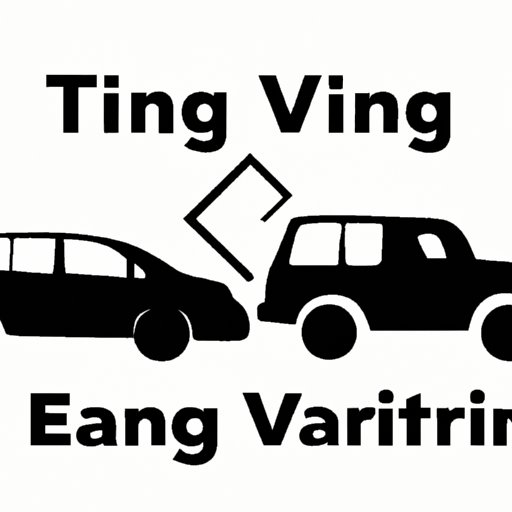
I. Introduction
When you have a financed car and decide it’s time to move on, you may be wondering how soon you can trade it in. Trading in a financed car comes with its own unique set of challenges, and many people are unsure of the process. This article aims to provide you with information on the basics of trading in a financed car, tips on how to determine the right time to trade-in, and your options when trading in a financed car with bad credit.
II. The Basics of Trading in a Financed Car
Trading in a financed car means selling your car to a dealership or an individual while you still owe money on the loan or lease. The dealership or buyer will use the value of your car minus the amount you owe to pay off the loan. The rest of the money will be given to you as a down payment for your next car or in cash.
The process for trading in a car typically involves appraising the vehicle, paying off the remaining balance on the loan, and then using any leftover equity to put towards a new car. One advantage of trading in a financed car is that it can simplify the process of buying a new car, as you can use any equity towards the down payment on your new car. However, the disadvantage of trading in a financed car is that if your car’s value is less than the balance on your loan, you will be upside down on the loan and may need to pay the difference.
III. Can You Trade in a Financed Car for a Lease?
When trading in a financed car, you can opt to get another purchased car or a leased car. Leasing a car is like renting it for an extended period, and it’s a cost-effective way to drive a new car. One of the benefits of trading in a financed car for a lease is that the car will have a lower monthly payment than if you were to purchase the car outright. However, there are limitations to how much you can drive the car per year, and there may be added fees if you go over the contracted mileage.
Before trading in your financed car for a lease, you should consider your personal preferences, driving habits, and budget. Buying a car is typically more expensive upfront, but the car is eventually yours. Leasing a car means you will have lower monthly payments, but you will never actually own the car, and there may be added fees or limitations.
IV. Why it Could be Beneficial to Trade in Your Financed Car Early
There are several advantages to trading in a financed car early. One of the most significant benefits is that you can access equity sooner, which you can use towards a new car or other expenses. You may also be able to negotiate a better value for your current car if it is still in good condition with low mileage on the odometer. In some cases, car models may have a higher resale value earlier in their life cycle, so trading in early is ideal in those situations.
Common reasons why people trade in their financed car early include a decrease in financial stability, such as a job loss, increase in family size, or a change in lifestyle. If you’re experiencing these changes and need a car that better suits your needs, it may be worth considering trading in early.
V. How to Determine the Right Time to Trade in a Financed Car
Determining the right time to trade in a financed car can be a difficult decision. Several factors to consider include the current value of the car, the remaining loan amount, and your overall financial situation. One tip for assessing whether it’s the right time to trade in a car is to check the current trade-in value for your car and compare this to the remaining loan balance. If the car’s value is higher than the remaining loan balance, you may have equity that you can put towards a new car.
Other factors to consider when making the decision include the car’s age, mileage, and condition. For example, if you have a newer car with low mileage on the odometer and it’s in excellent condition, you’re likely to get a higher trade-in value. Additionally, you should consider whether you’re financially stable enough to pay for a new car monthly, with car payments, insurance, and maintenance costs all adding up.

VI. What You Need to Know About Negative Equity When Trading in a Financed Car Early
Negative equity is when you owe more on the car than it’s worth. This can happen when the value of the car has decreased more quickly than you’ve paid off the loan. If you’re trading in a financed car early and have negative equity, be prepared to pay the difference between the remaining loan balance and the car’s value.
If possible, it’s best to avoid trading in a financed car if you have negative equity. Instead, you may want to work on paying down the loan balance and building equity in your car before considering a trade-in. Another option is to roll the negative equity into the loan for the new car, which will mean higher monthly payments, but it may be a workable solution for some people.
VII. Your Options for Trading in a Financed Car with Bad Credit
Having bad credit can impact your chances of being approved for a car loan or trade-in. However, if you have bad credit and need to trade in a car, you still have options. One option is to work with a dealership that specializes in bad credit auto loans. These dealerships often have relationships with banks and other lenders that specialize in bad credit loans. Another option is to find a cosigner with good credit to increase your chances of being approved for a loan or trade-in.
It’s essential to have realistic expectations when trading in a financed car with bad credit. You may have higher monthly payments or more fees, and you may need to accept a high-interest rate, which can cost more in the long run.
VIII. The Pros and Cons of Trading in a Financed Car Early Versus Waiting Until the End of the Loan Term
Deciding between trading in a financed car early versus at the end of the loan term can be a difficult decision. Trading in a car early means you can access equity sooner and have the flexibility to change cars to fit your current lifestyle or budget. However, trading in early may mean you have negative equity, which can be costly. On the other hand, waiting until the end of the loan term may mean that your car is less valuable, and you may have fewer options for trade-in.
Ultimately, the decision between trading in a financed car early or waiting depends on your personal situation and priority. If you can afford to wait and have no reason to change cars at the moment, waiting until the end of the loan term may make more sense. However, if you need a new car or want to switch cars for any reason, trading in early may be the right choice.
IX. Conclusion
Trading in a financed car is a complex process that requires careful consideration. Whether you’re trading in your financed car for a lease or another purchased car, it’s essential to be aware of the advantages and disadvantages of each option. By assessing your financial situation, considering your driving habits, and researching the current value of your car, you can make an informed decision about when to trade in your financed car. Remember to carefully consider your options and work within your budget to make a decision that will work for you.
Final tips for trading in a financed car include keeping the car in good condition, shopping around for different dealerships to find the best price, and being prepared to negotiate. By taking these steps, you can get the best possible value when trading in your financed car.





